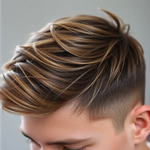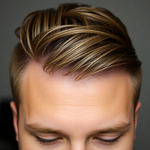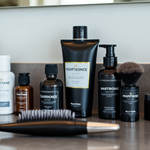
Mono-Hue Strategy: Semi-Permanent Hair Color to Streamline Your Sustainable Men's Capsule Wardrobe
08 September 2025
Share
Introduction
Struggling to look intentional without overbuying or overthinking every morning? The Mono-Hue Strategy: Semi-Permanent Hair Color to Streamline Your Sustainable Men's Capsule Wardrobe gives you one practical lever to lift your whole look. By aligning a subtle, semi-permanent hair tone with a tight, eco-conscious capsule wardrobe, you reduce decision fatigue, cut waste, and create a consistently sharp silhouette. Read on for step-by-step guidance, shade science, maintenance hacks, and capsule examples you can implement this weekend.
What Is the Mono-Hue Strategy?
The Mono-Hue Strategy is a simple concept: choose a hair tone that complements and anchors your limited wardrobe palette. Using semi-permanent hair color makes this achievable without long-term chemical commitment. Semi-permanent formulas deposit color onto the hair shaft and wash out over time, which means you can experiment with tone, adjust seasonally, and avoid repeated aggressive chemical processing.
Why the Mono-Hue Strategy Works (Practical Benefits)
- Visual coherence: Your hair becomes a deliberate element of your outfit palette, smoothing contrasts and elevating casual or lower-cost pieces.
- Less impulse buying: When everything matches, you notice fewer gaps in your closet and buy only what genuinely complements your base items.
- Time savings: A mono-hued look reduces morning outfit decisions—get dressed in 5–10 minutes.
- Lower environmental impact: Semi-permanent dyes and a pared-back capsule mean fewer products, less packaging, and less frequent wardrobe turnover.
Mono-Hue Strategy: Semi-Permanent Hair Color to Streamline Your Sustainable Men's Capsule Wardrobe (Shade Science)
Color theory matters. When your hair tone sits in harmony with clothing undertones (cool, warm, or neutral), textures and layers read as intentional. Semi-permanent dyes typically come in ash (cool), neutral, and warm tones. Choose one that complements your skin undertone and the dominant shades in your capsule.
Identify Your Personal Palette
- Audit your closet: Pull 12–20 frequently worn pieces and identify dominant colors. Are you mostly wearing navy, charcoal, and olive? Or camel, rust, and cream?
- Skin undertone check: Look at veins on your wrist—blue/purple suggests cool; green suggests warm; a mix suggests neutral. Neutral tones are the easiest to pair.
- Decide the contrast level: Low-contrast (close hair and clothing tones) gives a soft, modern look; high-contrast (dark hair with light clothing) reads sharper and more graphic.
Shade Recommendations by Wardrobe Type and Skin Tone
- Cool capsule (navy, charcoal, slate): Ash brown, espresso, or deep cool black. These provide seamless transitions and avoid clashing blue-based fabrics.
- Neutral capsule (olive, taupe, stone): Neutral brown or soft chestnut—balances both warm and cool elements.
- Warm capsule (camel, rust, khaki): Warm chestnut, honey brown, or black with brown highlights to pick up warm highlights in natural light.
- Gray or silver-forward look: Embrace ash tones or cool brown to keep the overall aesthetic minimal and modern.
Choosing Semi-Permanent Over Permanent: Pros & Cons
Semi-permanent dye is not a one-size-fits-all solution, but for the Mono-Hue Strategy it often hits the right balance:
- Pros: Lower commitment, gentler formulations (often ammonia-free), easier to adjust, less long-term damage.
- Cons: Fades quicker (requires more frequent refreshes), limited ability to lift natural color (mostly darkening or toning), variable longevity based on hair porosity and products used.
Step-by-Step: How to Apply Semi-Permanent Dye (At-Home or Salon)
- Patch test: Always test the product on a skin patch 48 hours before full application to check for allergy risks.
- Strand test: Apply a small amount on a hidden strand to preview color and timing.
- Prep: Start with unwashed hair (natural oils protect the scalp), read instructions, and use gloves and protective clothing.
- Application: Work in thin sections to ensure even coverage. Use a comb and dye brush for control.
- Processing: Follow the product timing; semi-permanent products usually need 10–30 minutes.
- Rinse & condition: Rinse until water runs clear and apply a color-safe conditioner or mask to lock moisture in.
- First 48 hours: Avoid heavy sweating, chlorinated pools, or saltwater to minimize early fading.
Maintenance Routine: Keep Tone & Reduce Waste
Extend your color and minimize environmental impact with simple swaps and schedule tweaks.
- Wash less, rinse smarter: Move to 2–3 washes per week where possible. Use cooler water to reduce color loss and energy use.
- Use concentrated, sulfate-free cleansers: Shampoo bars or concentrated refills reduce packaging waste and protect color.
- Refresh strategically: Semi-permanent color typically lasts 4–8 weeks depending on hair porosity and wash frequency—plan a refresh every 6–8 weeks for a consistent look.
- Protect from sun and chlorinated water: UV and chlorine accelerate fading—wear a hat or rinse and condition after exposure.
Everyday Styling to Complement Your Mono-Hue Capsule
Once your hair tone is set, your styling choices become clearer. Use texture and proportion to build interest without adding color clutter.
- Layer neutrals: Mix textures—cotton tee, wool knit, technical shell—to create depth while staying monochromatic.
- One statement piece: Add a single accent (a patterned shirt, a leather jacket) that picks up undertones from your hair.
- Accessories: Shoes, belts, and watch straps in complementary tones seal the look—Menll.com’s EcoSneak Casual Shoes work with most mono-hued palettes and are a durable, eco-minded pick.
Capsule Wardrobe Templates Aligned with Hair Tones
Below are three ready-to-adopt capsules for different style goals. Each keeps to 6–8 core pieces plus shoes and outerwear.
Minimal Urban Professional (Cool Hair Tones)
- White crew tee
- Charcoal merino knit
- Navy tailored chinos
- Charcoal or navy blazer
- Black leather boots
- Light jacket (technical shell)
Casual Weekend Operator (Neutral Hair Tones)
- Olive tee
- Stone henley
- Dark denim
- Khaki chore jacket
- Tan leather sneakers or Menll.com EcoSneak
- Wool beanie
Warm, Rugged Capsule (Warm Hair Tones)
- Camel sweater
- Rust overshirt
- Dark olive chinos
- Brown leather work boots
- Heavy coat (waxed or recycled insulation)
Adjusting Your Mono-Hue Strategy Seasonally
- Spring/Summer: Consider slightly lighter, warmer tones (subtle sun-kissed chestnuts) and swap heavier fabrics for breathable linens and cottons.
- Fall/Winter: Darken your tone marginally for depth—deep chocolate or cool espresso works well—and introduce textured knits and outerwear.
- Transitional fades: Let semi-permanent color fade into your natural shade instead of constant re-dying to minimize chemical use and upkeep cycles.
Safety, Ingredients & Sustainability Considerations
Semi-permanent formulas are often gentler, but you should still be mindful. Look for ammonia-free, low-PPD (p-phenylenediamine) options and transparent ingredient lists. Brands that publish refill programs, recyclable packaging, and cruelty-free certifications are preferable.
For safety information on hair dyes and ingredients, consult a trusted health resource like WebMD. If you have scalp conditions, consult a dermatologist before coloring.
Troubleshooting Common Issues
- Too warm after dye: Use a color-depositing cool shampoo or a blue/purple toning product to neutralize brassiness.
- Uneven fading: Adjust washing frequency, use less heat, and ensure even application next session or see a stylist.
- Scalp irritation: Rinse immediately and seek medical advice if severe. Stop use of offending product thereafter.
Cost-Benefit: Is It Worth It?
Think of the Mono-Hue Strategy as an investment in repeat wear and decisional simplicity. Costs include product or salon fees and maintenance; benefits are fewer impulse purchases, less closet churn, and a more confident appearance. Many men find the ROI appears within a few months—less wasted spending on mismatched items and fewer returns.
Case Study: Two-Month Transformation
Meet Alex, 32, marketing manager: he switched from a scattered closet to a navy-charcoal capsule and used a cool espresso semi-permanent dye. His morning routine went from 20 minutes and outfit stress to 7 minutes and consistent positive feedback at work. He replaced three seldom-worn jackets with one high-quality Menll.com outer layer and reports fewer impulse buys and a lower laundry load.
FAQ: Quick Answers
- How often will semi-permanent fade? Typically 4–8 weeks depending on frequency of washing and hair porosity.
- Can I go lighter with semi-permanent? No—semi-permanent dyes dont lift natural pigment. Use them to darken or tone, not to bleach.
- Is it safe for sensitive skin? Patch tests are essential; choose sensitive-skin formulas and consult a dermatologist if in doubt.
Action Plan: Implement Your Mono-Hue Strategy in 4 Steps
- Audit your wardrobe: Identify 6–8 core pieces and dominant color undertones.
- Pick a semi-permanent shade: Match undertone and choose a shade one step from your natural to keep it subtle.
- Apply and test: Do a patch and strand test, then apply at home or book a salon appointment.
- Set maintenance rituals: Swap to color-safe, low-waste products and plan refreshes every 6–8 weeks.
Product & Resource Suggestions
- Ammonia-free semi-permanent color (choose reputable brands with transparent ingredient lists)
- Sulfate-free, concentrated or bar shampoo
- Lightweight leave-in conditioner and a matte styling cream
- One high-quality, versatile outer layer from Menll.com to complete the capsule—check Menll.com's outerwear collection for durable, sustainable options at Menll.com Outerwear.
Final Thoughts
The Mono-Hue Strategy: Semi-Permanent Hair Color to Streamline Your Sustainable Men's Capsule Wardrobe is more than a grooming trick—it's a systems approach to dressing better with less. By controlling one variable (hair tone) you create multiplier effects across fit, color harmony, and wardrobe longevity. Whether you're a young professional, a budget-conscious student, or a style-focused beginner, this strategy helps you look put together without overconsumption.
Call to Action
Ready to try it? Pick one shade, audit your closet this weekend, and start small. What hair tone would you anchor your capsule to? Tell us in the comments below and explore Menll.com for sustainable essentials that fit a mono-hued life.
Suggested Meta
Meta title: Mono-Hue Strategy: Semi-Permanent Hair Color for Men
Meta description: Use the Mono-Hue Strategy with semi-permanent hair color to simplify your sustainable men's capsule wardrobe—shade picks, low-waste upkeep, and styling tips.
Prev post

Semi-Permanent Hair Color: Low-Waste Hack to Expand Your Men's Capsule Wardrobe
Updated on 09 September 2025






